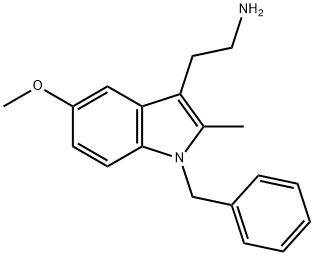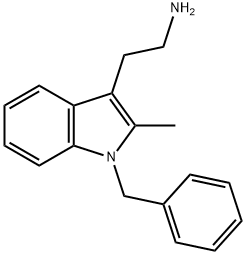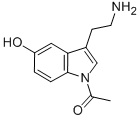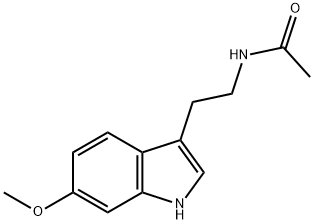1-(2,3-DICHLOROBENZOYL)-5-METHOXY-2-METHYL-3-[2-(4-MORPHOLINYL)ETHYL]-1H-INDOLE
Synonym(s):1-(2,3-Dichlorobenzoyl)-5-methoxy-2-methyl-(3-(morpholin-4-yl)ethyl)-1H-indole hydrochloride;L768;ML-SI1 hydrochloride
- CAS NO.:180002-83-9
- Empirical Formula: C23H24Cl2N2O3
- Molecular Weight: 447.35
- MDL number: MFCD08061200
- SAFETY DATA SHEET (SDS)
- Update Date: 2023-06-08 09:02:46
![1-(2,3-DICHLOROBENZOYL)-5-METHOXY-2-METHYL-3-[2-(4-MORPHOLINYL)ETHYL]-1H-INDOLE Structural](https://img.chemicalbook.in/CAS/GIF/180002-83-9.gif)
What is 1-(2,3-DICHLOROBENZOYL)-5-METHOXY-2-METHYL-3-[2-(4-MORPHOLINYL)ETHYL]-1H-INDOLE?
The Uses of 1-(2,3-DICHLOROBENZOYL)-5-METHOXY-2-METHYL-3-[2-(4-MORPHOLINYL)ETHYL]-1H-INDOLE
It is a potent and selective CB2 receptor partial agonist (EC50 = 0.65 nM; maximum inhibition = 44.6%). Binds with high affinity to both human and rat CB2 receptors and displays ~ 1200-fold selectivity over CB1 (Ki values are 3.92 and 4772 nM for human recombinant CB2 and CB1 receptors respectively). Produces potent antihyperalgesic effects in several rodent models of pain.
What are the applications of Application
GW-405833 is a CB2 partial agonist
Definition
ChEBI: (2,3-dichlorophenyl)-[5-methoxy-2-methyl-3-[2-(4-morpholinyl)ethyl]-1-indolyl]methanone is a N-acylindole.
Biological Activity
Potent and selective CB 2 receptor partial agonist (EC 50 = 0.65 nM; maximum inhibition = 44.6%). Binds with high affinity to both human and rat CB 2 receptors and displays ~ 1200-fold selectivity over CB 1 (K i values are 3.92 and 4772 nM for human recombinant CB 2 and CB 1 receptors respectively). Produces potent antihyperalgesic effects in several rodent models of pain.
Biochem/physiol Actions
GW405833 is a selective cannabanoid CB2 receptor agonist; analgesic. GW405833 binds with high affinity at both human and rat CB2 receptors (Ki′s 3.9 and 3.6 nM); acts as a partial agonist (50% inhibition of forskolin-stimulated cAMP formation compared to full agonist CP55,940). GW405833 has potent analgesic activity in rat models of inflammatory, neuropathic and incisional pain; devoid of CNS effects common with CB1 agonists.
Properties of 1-(2,3-DICHLOROBENZOYL)-5-METHOXY-2-METHYL-3-[2-(4-MORPHOLINYL)ETHYL]-1H-INDOLE
| Melting point: | 47-49℃ |
| storage temp. | 2-8°C |
| solubility | Soluble in DMSO at 10-15mg/ml. Also soluble in ethanol at ~5mg/ml. |
| form | solid |
| color | tan |
Safety information for 1-(2,3-DICHLOROBENZOYL)-5-METHOXY-2-METHYL-3-[2-(4-MORPHOLINYL)ETHYL]-1H-INDOLE
| Signal word | Danger |
| Pictogram(s) |
 Skull and Crossbones Acute Toxicity GHS06 |
| GHS Hazard Statements |
H301:Acute toxicity,oral H413:Hazardous to the aquatic environment, long-term hazard |
| Precautionary Statement Codes |
P273:Avoid release to the environment. |
Computed Descriptors for 1-(2,3-DICHLOROBENZOYL)-5-METHOXY-2-METHYL-3-[2-(4-MORPHOLINYL)ETHYL]-1H-INDOLE
New Products
4-AMINO-TETRAHYDRO-PYRAN-4-CARBOXYLIC ACID HCL 4-(Dimethylamino)tetrahydro-2H-pyran-4-carbonitrile 4-Aminotetrahydropyran-4-carbonitrile Hydrochloride (R)-3-Aminobutanenitrile Hydrochloride 3-((Dimethylamino)methyl)-5-methylhexan-2-one oxalate 1,4-Dioxa-8-azaspiro[4.5]decane 5-Bromo-2-nitropyridine Nimesulide BP Aceclofenac IP/BP/EP Diclofenac Sodium IP/BP/EP/USP Mefenamic Acid IP/BP/EP/USP Ornidazole IP Diclofenac Potassium THOMAIND PAPER PH 2.0 TO 4.5 1 BOX BUFFER CAPSULE PH 9.2 - 10 CAP SODIUM CHLORIDE 0.1N CVS ALLOXAN MONOHYDRATE 98% PLATINUM 0.5% ON 3 MM ALUMINA PELLETS (TYPE 73) LITHIUM AAS SOLUTION 2-Bromo-1-(bromomethyl)-3-chloro-5-nitrobenzene 2-Bromo-3-nitroaniline N-(3-Hydroxypropyl)-N-methylacetamide 3-Bromo-6-chloropyridazine 4-ethyl-3-nitrobenzoic acidRelated products of tetrahydrofuran





![1-(2,3-DICHLOROBENZOYL)-5-METHOXY-2-METHYL-3-[2-(4-MORPHOLINYL)ETHYL]-1H-INDOLE](https://img.chemicalbook.in/CAS/GIF/180002-83-9.gif)
You may like
-
 GW405833 hydrochloride CAS 180002-83-9View Details
GW405833 hydrochloride CAS 180002-83-9View Details
180002-83-9 -
 1-Methyl-6-oxo-1,6-dihydropyridazine-3-carbonitrile 98%View Details
1-Methyl-6-oxo-1,6-dihydropyridazine-3-carbonitrile 98%View Details
99903-60-3 -
 1823368-42-8 98%View Details
1823368-42-8 98%View Details
1823368-42-8 -
 2-(3-(tert-butyl)phenoxy)-2-methylpropanoic acid 1307449-08-6 98%View Details
2-(3-(tert-butyl)phenoxy)-2-methylpropanoic acid 1307449-08-6 98%View Details
1307449-08-6 -
 Ethyl 3-(furan-2-yl)-3-hydroxypropanoate 25408-95-1 98%View Details
Ethyl 3-(furan-2-yl)-3-hydroxypropanoate 25408-95-1 98%View Details
25408-95-1 -
 2-Chloro-5-fluoro-1-methoxy-3-methylbenzene 98%View Details
2-Chloro-5-fluoro-1-methoxy-3-methylbenzene 98%View Details
1805639-70-6 -
 1784294-80-9 98%View Details
1784294-80-9 98%View Details
1784294-80-9 -
 Lithium ClavulanateView Details
Lithium ClavulanateView Details
61177-44-4